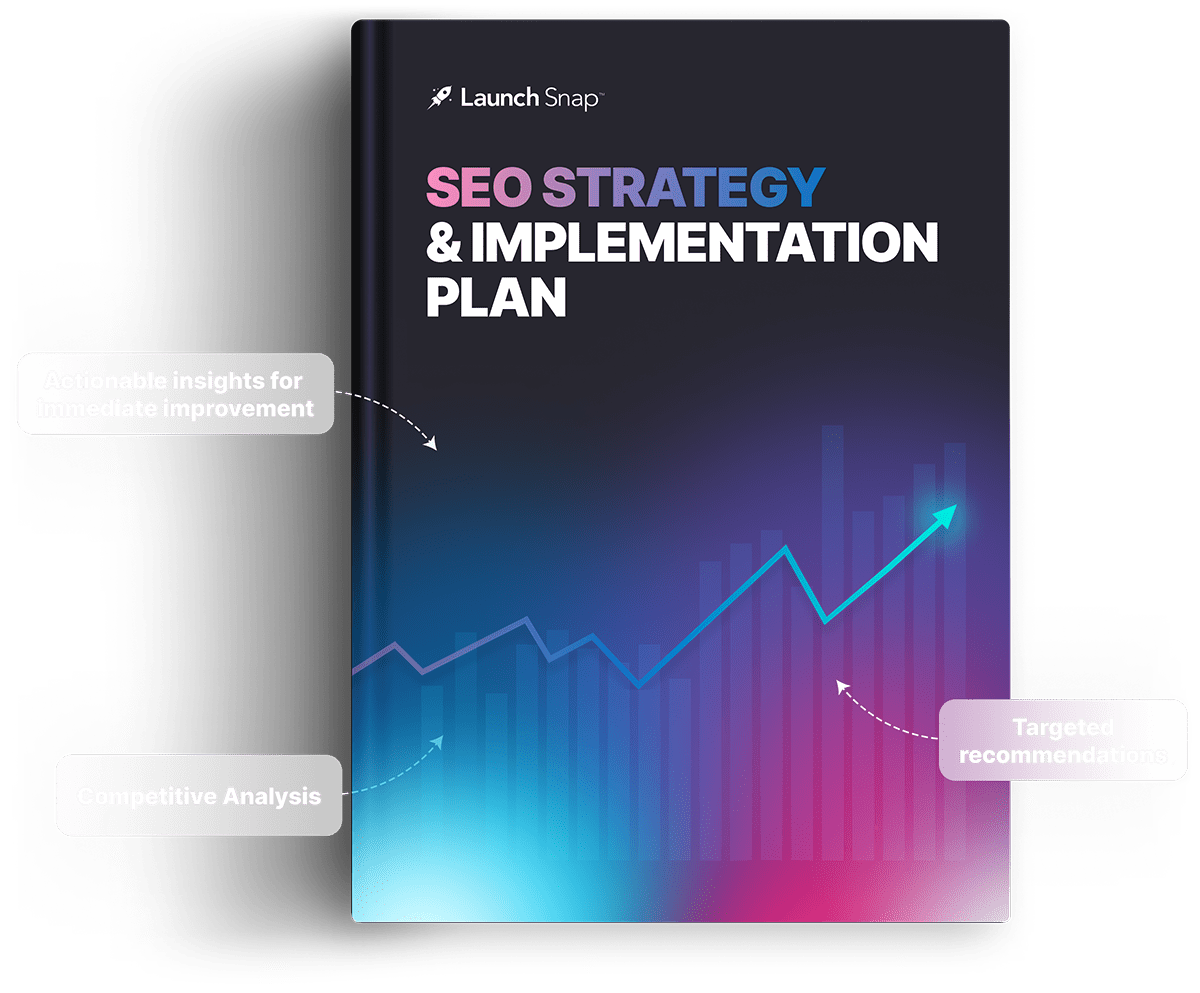12 Ways to Measure if Your B2B SEO is Working
They are common questions: Is the time and energy we are putting into search engine optimization working? How do we measure the effects of our SEO efforts? You need reports that give you a moment in time as well as show the trend over time. The level of detail and most valuable KPIs to include vary from business to business. (For this reason, at LaunchSnap, we create custom SEO reporting on a client by client basis.)

Here’s the big picture of which metrics to consider, which tools to use and what to look for:
Organic Traffic Analysis
In the simplest terms, your search engine optimization efforts should lead to increases in organic traffic. As a result, organic traffic is a critical component of the “big picture,” and is often seen as a natural and credible yardstick of your site’s visibility in search results thanks to your SEO efforts. Here are the various elements that come in to play as you’re performing this kind of analysis:
Overall Trends:
Use a tool such as Google Analytics to track overall patterns in the quantity of organic traffic. An upswing of organic visitors reflects that your organic SEO is yielding the desired results.
Segmented Analysis:
Break down the organic traffic based on demographics, device types, and geographical locations. This will help you understand which segments are benefiting most from your SEO efforts.
Best Tool to Use
- Google Analytics:
Utilize this tool to monitor the overall organic traffic and segment it by demographics, device types, and geographical locations.
Keyword Rankings and Visibility
Keyword rankings are an obvious indicator that reflect where your content matches what users are searching for. Heightened rankings mean that your website is considered more relevant and authoritative for these terms.
Target Keywords Performance:
Track how well your targeted keywords are ranking in search engine result pages (SERPs) using SEO tools such as SEMrush, Ahrefs, or Google Search Console. Noticeable improvements in rankings can indicate effective SEO.
SERP Features:
Pay attention to your presence in various SERP features like featured snippets, local packs, or knowledge panels. These can significantly enhance visibility and click-through rates.
Best Tools to Use:
- Google Search Console:
Monitor the keywords you’ve been optimizing for targeting. - SEMrush or Ahrefs:
These tools can provide additional keyword ranking data and insights.
Tip #1: Balance
Effective SEO reporting strikes the perfect balance, providing just enough data to drive informed decisions without drowning you in unnecessary detail.
Click-Through Rates
A Higher Click-Through Rate (CTR) means more people are clicking on your link on the SERP.
CTR Trends:
Watch how your CTR’s change over time. An increasing CTR means that your page titles and meta descriptions are compelling and relevant to the search queries your listings are appearing for.
Page-wise Analysis:
Investigate CTR at an individual page level to identify which pages are performing well and which need optimization.
Best Tools to Use:
- Google Search Console:
This is the ideal tool for analyzing the CTR for your organic search listings and obtaining data for specific keywords and pages.
Conversion Rates
Conversion rates from organic traffic are a key aspect to monitor to understand how effectively your SEO is translating into tangible results, such as leads or sales, which contribute to your bottom line.
Goal Conversion Tracking:
Different companies have different conversion goals. Some examples include form completions, newsletter sign-ups, time spend on the site, watching a proportion of videos, etc. No matter what your conversion metric is, you want to track that your SEO efforts are leading to those conversions.
Funnel Analysis:
Look at the conversion paths for organic traffic to understand how visitors navigate through your site and which pages are most influential in driving conversions.
Best Tool to Use
- Google Analytics:
Assess the conversion rates to track how well these conversions align with your set goals.
User Engagement Metrics
User engagement metrics will give you a sense of how visitors are interacting with your website overall.
Engagement Rate: With the introduction of Google Analytics 4, bounce rate was replaced with engagement rate. You can still calculate bounce rate though. It’s the opposite of the engagement rate. Both metrics are telling you whether someone came to your site and interacted or just left right away.
Average engagement time: Similarly, time on page was replaced with average engagement time. This quantifies how long a visitor stayed on your site. Longer times are better and indicate that your content is both valuable and relevant to your audience.
Best Tool to Use
- Google Analytics:
Use this to examine metrics such as bounce rate and dwell time on your site and on individual pages.
Develop a Backlink Profile
The amount and quality of backlinks to your website indicates the level of the trust and authority of your content in the eyes of search engines. Many argue that backlinks are the single more important aspect of an SEO strategy.
Quality and Quantity: Keep tabs on the accumulation of new backlinks and assess the authority and relevance of the linking site. A noticeable increase from well-reputed backlinks can have a significant effect on your SEO performance.
Link Audits: Regular backlink audits of your website are a must. You must identify and disavow toxic or spammy links that could lead to search engine penalties.
Best Tools to Use:
- SEMrush or Ahrefs:
These tools are excellent for monitoring the growth and quality of backlinks to your website. - Google Search Console:
Also useful for viewing some backlink data, though not as comprehensive as Ahrefs or SEMrush.
Website Indexation Status
If you want your site to show up in search results, you have to make sure the search engines crawl it.
Index Coverage: Regularly checking the index status ensures that your content is visible and capable of ranking.
Technical SEO Checks: Resolve any crawl errors or indexation problems reported in tools like Google Search Console to improve your site’s SEO health.
Best Tools to Use:
- Google Search Console:
This is the primary tool for checking which of your pages are indexed and identifying any indexation issues.
Load Speed and UX
A site that is slow to load creates a poor user experience and the search engines factor that in when determining rankings.
Speed Metrics: Check your loading times on desktop and mobile. Faster load times improve the user experience in general and can help with SEO.
User Experience (UX) Improvements: Work to implement changes through various UX best practices so that your website can be navigated, interacted with, and understood thoroughly by any user on both desktop and mobile platforms.
Best Tool to Use
- Google PageSpeed Insights:
This tool evaluates the loading speed of your pages and provides recommendations for improvement. - Google Analytics:
It can help track various user experience metrics, although for speed-specific insights, PageSpeed Insights is more direct.
Mobile Optimization
Just like page load speed, Google knows that more and more people are visiting websites on their phones. A good mobile experience is not only good for SEO, it’s better for your visitors.
Responsive Design Check:
Ensure your website is mobile-friendly. This means it should pass Google’s Mobile-Friendly Test. You can’t afford to skip this, since mobile-friendliness is now a critical ranking factor for search engines.
Mobile User Behavior:
Use Google Analytics to understand how mobile users are interacting with your site as opposed to desktop users and make that they find in yours what they would in a desktop environment, and also take advantage of things they can only do with their handheld device.
Best Tools to Use:
- Google’s Mobile-Friendly Test:
Use this to check the mobile responsiveness of your website. - Google Search Console:
It also provides reports on mobile usability issues that can affect your site’s performance in mobile search results.
Tip #2: Make it Light
Hiding heavy-load images or rich media content that isn’t optimal on mobile devices significantly improve user experience and SEO, ensuring faster load times and a smoother browsing.
Local SEO
If you have one or many physical locations, especially if they are open to the public, take advantage of Google’s local business tools to capture local search traffic and engaging with the community.
Local Search Rankings:
For businesses with a physical presence, monitor your rankings in local search results and on maps. High local rankings can lead to increased foot traffic and local customer engagement.
Local Listings Consistency:
Make sure your business information (name, address, phone number) is consistent and accurate across all online directories to improve local search visibility.
Best Tool to Use
- Google My Business Insights:
This is useful for businesses with a physical presence to monitor local SEO metrics like local rankings and customer engagement. - Google Analytics and Google Search Console:
Both can provide data on how local visitors are interacting with your site.
Financial Impact and ROI
Ultimately, the proof of SEO success is its impact on your business’s financial goals. Understanding the ROI from your SEO campaigns can help justify continued investment and inform future strategy.
Revenue Tracking:
Assess the revenue generated directly from organic traffic and compare this to your SEO investment, to calculate the ROI.
Cost-Benefit Analysis:
Compare the costs associated with SEO activities to the benefits in the form of increased traffic, conversions, and revenue — to understand the overall financial impact of your SEO efforts.
Best Tool to Use
- Google Analytics:
Utilize this for tracking revenue generated from organic traffic and calculating the ROI of your SEO efforts, especially when combined with goal conversion tracking.
Experimentation and Refinement
Unfortunately, you can’t just set up your SEO and then forget about it. You need to add fresh content, experiment and try different approaches all while analyzing results and refining strategies.
Test Different Keyword Strategies:
Engage in A/B testing with various keyword combinations to ascertain the most effective approach.
Iterate Based on Data:
Continuously adjust and refine your keyword and content strategies based on analytical insights and evolving business objectives Ensuring your SEO strategy is current with the best possible outcomes.
Transform Data into Strategy
Feeling buried by SEO metrics without any clue how to make sense of reports? You’re not alone.
At LaunchSnap, we live for this stuff. We cut through dense analytics to help you answer one vital question — what’s working? And once you have that answer, we help you make a plan to keep getting results and drive meaningful business success. Ready to lead the pack on search with an unbeatable online presence? Start your journey towards data-driven success, contact LaunchSnap right now.



